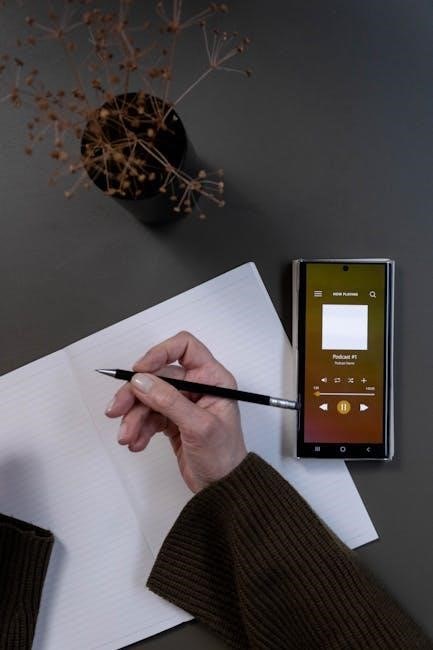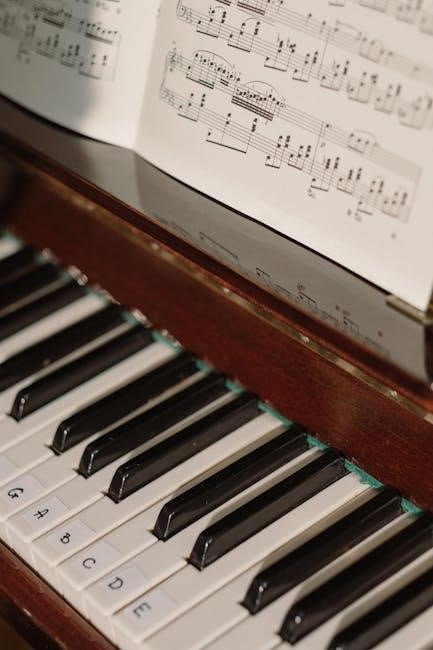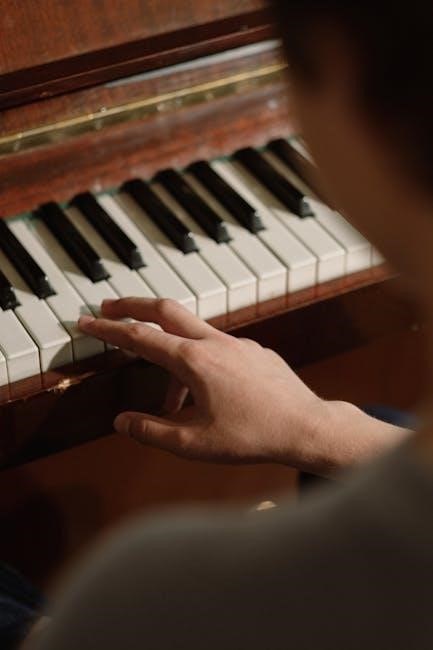Music note flashcards are a fantastic tool for anyone wanting to learn to read music. Whether you are a beginner or a more advanced player, music note flashcards can help you improve your music reading skills.

Why Use Music Note Flash Cards?
Music note flashcards are a popular and effective way to learn and memorize music notes. They offer a simple, portable, and interactive method for reinforcing note recognition, ultimately improving your overall music reading ability;
Improving Note Recognition
Music note flashcards are an invaluable tool for improving note recognition skills, a fundamental aspect of music literacy. By repeatedly exposing learners to music notes in a concise and focused manner, these flashcards facilitate rapid memorization and recall. This repetitive process helps to solidify the association between the visual representation of a note on the staff and its corresponding name and pitch.
Through consistent practice with flashcards, individuals can gradually increase their speed and accuracy in identifying notes. This enhanced recognition ability translates directly into improved sight-reading skills and a more fluid and confident approach to playing music. Regular use of music note flashcards fosters a deeper understanding of musical notation, paving the way for more advanced musical pursuits. They are an excellent resource for musicians of all levels looking to sharpen their skills.
Effective note recognition is the bedrock of musical proficiency.
Enhancing Music Reading Skills
Music note flashcards are instrumental in enhancing music reading skills, a crucial ability for any musician. Consistent use of these flashcards trains the brain to quickly recognize notes on the staff, leading to improved sight-reading proficiency. By repeatedly associating the visual representation of a note with its corresponding pitch and name, learners develop a strong foundation for understanding musical notation.
This enhanced recognition translates directly into the ability to interpret and perform music more fluently and accurately. Regular practice with flashcards fosters a deeper understanding of musical patterns and relationships, enabling musicians to anticipate upcoming notes and phrases. As music reading skills improve, musicians gain confidence and independence, allowing them to explore a wider range of musical repertoire.
Music note flashcards are a simple yet effective tool to elevate your music reading abilities.
Free Printable Music Note Flash Cards: PDF Resources
Looking for free resources? PDF music note flashcards are readily available online. These printable flashcards offer a convenient and cost-effective way to improve your musical skills for piano and guitar.
Where to Find Free PDF Flash Cards
Many websites offer free printable music note flashcards in PDF format. Sites dedicated to music education, such as Lessonface, often provide these resources to aid students in learning to read music. You can also find them on blogs and educational resource sites that cater to parents, teachers, and homeschoolers.
When searching, look for sites that offer a variety of flashcard types, including those for treble clef, bass clef, and different instruments like piano and guitar. Some sites may require you to register or provide basic information before downloading, while others offer direct downloads.
Always ensure that the flashcards are clear and easy to read, with accurate notation. Consider printing them on cardstock for durability. With a little searching, you can find a wealth of free PDF flashcards to support your music learning journey, including options with guidelines for easy cutting.
Types of Flash Cards Available (Treble, Bass Clef, etc.)
When exploring music note flashcards, you’ll find various types tailored to different instruments and clefs. Treble clef flashcards are essential for instruments like the piano (right hand), guitar, flute, and violin. Bass clef flashcards are crucial for instruments such as the piano (left hand), bass guitar, cello, and trombone.
Beyond these, you might encounter flashcards for alto and tenor clefs, used by instruments like the viola and some trombone parts. Some sets include accidentals (sharps and flats) and key signatures to enhance your understanding of music theory. Flashcards can also focus on specific ranges of notes or particular musical symbols, such as rests and dynamics.
The best choice depends on your instrument and learning goals. Many resources offer comprehensive sets covering multiple clefs and concepts, ensuring a well-rounded music education, including options designed for piano, guitar, and general music theory.

How to Use Music Note Flash Cards Effectively
To use music note flashcards effectively, start with short, regular practice sessions. Focus on accuracy before speed, and gradually increase the difficulty as you improve music reading skills.
Tips for Beginners
When you are first starting out with music note flashcards, it’s crucial to keep a few key principles in mind. Begin by focusing on just a few notes at a time, such as those on the treble clef or bass clef. This will help you avoid feeling overwhelmed and allow you to build a solid foundation.
Use the flashcards in short, frequent sessions to maintain focus and prevent burnout. Aim for daily practice, even if it’s only for five to ten minutes. Consistency is more important than the duration of each session.
Start with landmark notes like middle C, F, and G, and gradually add more notes as you become comfortable. Use mnemonic devices or other memory aids to help you remember the notes. Don’t be afraid to make mistakes; they are a natural part of the learning process.
Make sure you have the PDFs ready to print!
Practice Techniques for Advanced Learners
For advanced learners, music note flashcards can still be a valuable tool for maintaining and improving your skills. Focus on speed and accuracy by timing yourself as you go through the flashcards. Aim to decrease the amount of time it takes you to identify each note correctly. It is important to test yourself!
Incorporate intervals, chords, and rhythms into your flashcard practice. This will help you develop a more comprehensive understanding of music theory. You should also create your own custom flashcards with more challenging notes or musical symbols.
Try to practice in different clefs, such as alto or tenor clef, to expand your reading abilities. Use the flashcards as a warm-up before practicing your instrument or as a way to reinforce concepts learned in lessons. Remember to stay challenged, and you will improve!
You can find free PDFs online!

Creating Your Own Music Note Flash Cards
Creating your own music note flashcards allows you to personalize your learning experience and focus on specific areas where you need the most improvement. Start by gathering blank index cards or cardstock. You can also use a computer program to design and print your flashcards for a more polished look.
Include the notes you want to practice, such as those in the treble clef, bass clef, or other clefs. Add accidentals (sharps, flats, naturals) to challenge yourself further. You can also incorporate rests, rhythms, and other musical symbols. Be sure to write clearly and legibly so that the notes are easy to identify.
Consider adding a visual aid, such as a keyboard diagram, to help you associate the note on the staff with its corresponding key. Get free printable resources online, such as PDFs, so you can create personalized flashcards!
Flash Card Variations for Different Instruments
Adapt your music note flashcards to suit your instrument! Different instruments use different clefs and ranges. Tailor the flashcards to include the notes most relevant to the instrument you are learning.
Piano Flash Cards
Piano flashcards are specifically designed to help pianists learn to read music. They cover both the treble and bass clef because pianists must be proficient in reading both. Piano flashcards often include notes from the grand staff, encompassing a wide range of pitches.
Using flashcards, you can practice recognizing notes on the staff and relating them to the keys on the piano. Many piano flashcards include ledger lines, which extend above and below the staff, introducing notes beyond the standard range.
When creating or using piano flashcards, ensure they cover the common notes in piano repertoire. Regular practice with these flashcards will significantly improve your sight-reading skills, making it easier to learn and play new pieces. Furthermore, consider including flashcards that focus on intervals and chords to enhance your overall musical understanding and piano playing ability.
Guitar Flash Cards
Guitar flashcards are tailored for guitarists, focusing on the treble clef, which is primarily used for guitar music. These flashcards help guitarists quickly identify notes on the fretboard and correlate them to their positions on the staff. They often include diagrams showing where each note is located on the guitar neck.
Guitar flashcards can also incorporate information about different octaves and string numbers, making it easier to navigate the instrument. Some advanced flashcards might feature common chord voicings or scale patterns to improve improvisational skills.
Using guitar flashcards regularly can enhance sight-reading and understanding of music theory for guitarists. By practicing with these flashcards, guitarists can develop a strong connection between written music and the physical act of playing the instrument. This leads to better performance and a deeper appreciation for music.

Online Music Note Flash Card Resources
There are many online resources available for music note flashcards, offering interactive and customizable ways to practice. Websites like Lessonface provide free printable flashcards in PDF format, covering treble and bass clef notes. These resources often include guidelines for easy cutting.
Quizizz features a curated collection of music note flashcards suitable for learners of all ages. These online flashcards are designed to make learning fun and effective. For those seeking a more interactive experience, Musicards offers highly customizable online music theory flashcards.
Additionally, many apps and websites offer digital flashcards with features like spaced repetition and progress tracking. These online tools can be particularly useful for self-paced learning and provide immediate feedback, making it easier to master music note recognition. Whether you prefer printable or digital options, there are plenty of online resources to support your music education.
